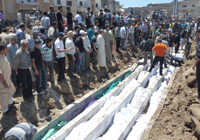
UN council condemns Syria over massacre
United Nations, May 28, 2012
The UN Security Council on Sunday unanimously condemned the killing of at least 108 people, including many children, in the Syrian town of Houla.
Meanwhile, the Syrian government and rebels blamed on each other for the massacre.
Images of bloodied and lifeless young bodies, laid carefully side by side after the onslaught on Friday, triggered shock around the world and underlined the failure of a six-week-old UN ceasefire plan to stop the violence.
Western and Arab states opposed to Syrian President Bashar Al-Assad put the blame for the deaths squarely on the government. But Damascus rejected the charge.
"The Security Council condemned in the strongest possible terms the killings, confirmed by United Nations observers, of dozens of men, women and children and the wounding of hundreds more in the village of (Houla), near Homs, in attacks that involved a series of government artillery and tank shellings on a residential neighbourhood," the non-binding statement said.
"Such outrageous use of force against civilian population constitutes a violation of applicable international law and of the commitments of the Syrian Government under United Nations Security Council Resolutions," the statement said.
The UN believes that at least 108 people were killed in Houla, UN peacekeeping chief Herve Ladsous said.
Russia, which along with China has vetoed two Security Council resolutions calling for tougher action against Damascus, said the "tragic" events in Syria deserve condemnation and called for a UN assessment of the violence there.
Russian Deputy UN Ambassador Alexander Pankin said the circumstances surrounding the massacre were "murky" and rejected the idea that the evidence clearly showed Damascus was guilty.
The head of the UN observer force, General Robert Mood, briefed the council by video link. Pankin said Mood "did not link directly the (army's) shelling with numbers of deaths."
UN Secretary-General Ban Ki-moon sent the council a letter that appeared to give ammunition to both sides. He said the observers "viewed the bodies of the dead and confirmed from an examination of ordnance that artillery and tank shells were fired at a residential neighbourhood." The rebels do not have artillery and tanks.
But Ban also said UN monitors observed shotgun wounds on some of the bodies, which could indicate close-range attacks by rebels, as Pankin suggested, or could be the result of follow-up attacks by the army after it stopped shelling.
"While the detailed circumstances are unknown, we can confirm that there has been artillery and mortar shelling," Ban said. "There have also been other forms of violence, including shootings at close range and severe physical abuse." - Reuters







